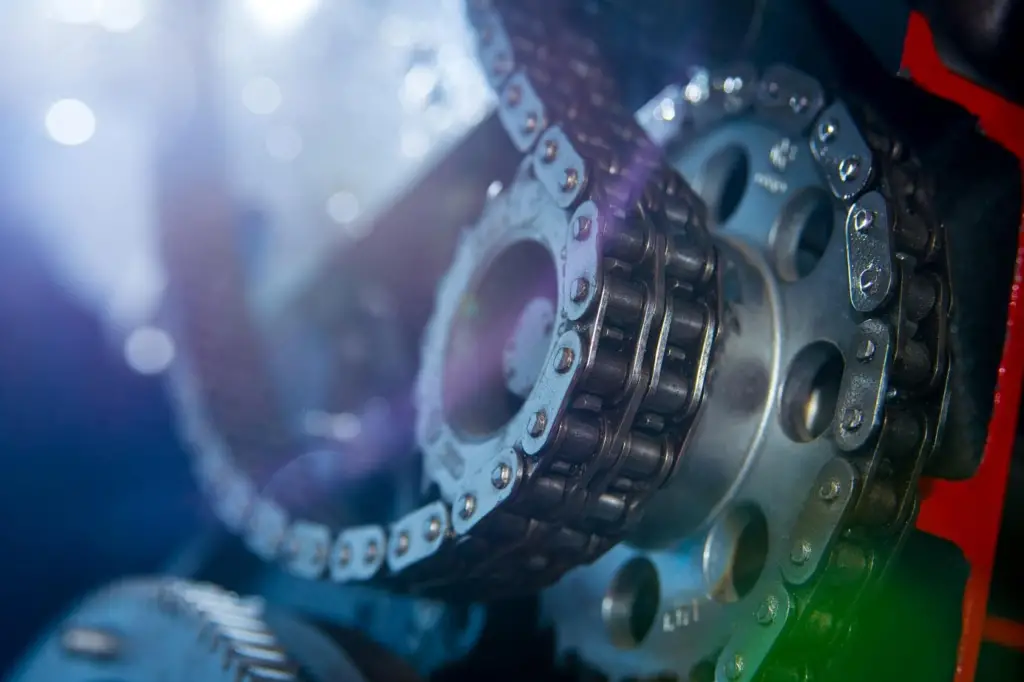As we have discussed many times in this blog, all internal combustion vehicles need to use a chain or timing belt to synchronise the different mechanical components that make up the engine. The chain has many advantages over the belt, as they are designed to last as long as the vehicle itself. This element is located at the front of the engine and is connected to a set of gears and pulleys that provide power to multiple mechanical components, including the crankshaft and camshaft. For the engine to start, the timing chain must rotate smoothly around the sprocket with no difficulty. Although the timing chain is made of tough metallic materials, it is subject to wear and tear and can break. This breakage can be caused by either poor maintenance or a factory defect and can lead to total engine failure if the chain is not replaced if necessary.
The timing chain consists of a series of links, similar to the links in a bicycle chain. The connecting rods move on toothed sprockets located at both ends of the crankshaft and camshaft. These sprockets are responsible for opening and closing the valves in the cylinder head and moving the pistons and connecting rods in the combustion chamber. During its lifetime, the timing chain can become stretched and worn over use or time, which will cause the engine timing to be inaccurate. Fortunately, it is these timing faults that will give us the clue that something is wrong under our hood. Take note, because these are the 5 symptoms that give away that we have a problem with our timing chain.
1. Misfiring or poor engine performance

If there are problems with our chain, it may happen that over a period of time, the timing chain stretches, momentarily slipping off the cam or crankshaft sprocket. This can cause the engine timing to exceed the calibration range and often lead to misfiring. The engine may also run poorly and lack acceleration power. If this happens often, the timing chain may be damaged and should be replaced as soon as possible.
2. Metal shavings in the oil

Most car manufacturers recommend changing the oil and filter at approximately 5,000 to 10,000 kilometres (although this may vary depending on the oil used). Over time, the oil begins to separate as it warms up and comes into contact with the natural solvents in the petrol. If the timing chain begins to wear, small strands of metal will break away from the chain and enter the oil sump.
If you find small bits of metal stuck in the filter or scattered in the fluid when changing the oil, you should know that your timing chain is starting to fail. This is one of the best indicators of timing chain failure. Metal shavings are also common when cylinder head valves, seals, cages and other cylinder head fittings become excessively worn. If this happens to you, take photos and take your car to a mechanic to have the problem checked and appropriate repairs made as soon as possible.
3. Engine creaks when idling

Abnormal sounds are also a common warning sign of internal engine problems. Under normal conditions, the engine should have a steady sound, indicating that everything is operating normally. However, when the timing chain is loose, it can cause vibrations inside the engine and a rattling sound may occur when the engine is idling. Rattling always means that something is loose inside the engine, so it must be intervened before it can break and cause further damage.
4. Engine Failure Warning Light on the Switchboard

The “check engine” light might turn on for many reasons, one of which may be a timing chain malfunction. The car’s on-board computer will display a warning light, which should be checked and scanned for fault codes to determine the source of the problem. When the ECU detects a problem with the exhaust system or a problem with the engine operation, the “check engine” light may switch on.
Stretching of the timing chain will result in decreased engine performance and increased emissions, which will activate the “check engine” light and store the diagnostic trouble code. If you don’t want to make your life mopre complicated, all you have to do is simply take the car to the garage. The mechanic will find the fault code using his diagnostic machine via the vehicle’s OBD socket. If, on the other hand, you like to play mechanics or want to go a little deeper into the subject, you can use a fault code reader. They are quite affordable and are extremely useful for clearing the list of already fixed faults, removing warning lights from the dashboard or diagnosing problems with your vehicle before they show their face.
- 【 EXTENSA COBERTURA 】: El lector de códigos OBD2 AL319 funciona en la mayoría de los vehículos consulte si no sabe si su coche es OBD2 compatible con protocolo OBD2 (equipados con un puerto de datos de 16 pines). También soporta varios idiomas: español, inglés, francés
- 【 APAGADO MIL 】: Autel AL319 le inidica la causa de la Luz de error (MIL), apagar la luz de aviso, borra los códigos y reinicia los monitores y determina la necesidad de un mecánico si la luz vuelve a encenderse
- 【 INFORMACIÓN RECUPERABLE 】: En cuanto a la extracción de información puede recuperar códigos genéricos (P0, P2, P3 y U0), específicos del fabricante (P1, P3 y U1), códigos pendientes e información del vehículo (VIN, CIN y CVN)
- 【 BÚSQUEDA DE DTC 】: Esta herramienta de escaneo de Autel OBD2 soporta la muestra de definiciones de DTC en la pantalla de color TFT. Por tanto, puede descubrir la causa principal de la avería de su automóvil de forma intuitiva sin necesidad de buscar en Internet
- 【 PANTALLA Y GARANTÍA 】: Este lector de códigos está equipado con una pantalla LED a color (220 x 176 ppp) para una excelente visualización y tiene una garantía de 12 meses y servicio en línea las 24 horas
5. The engine does not start or runs rough

A damaged timing chain will cause the engine not to start or to run poorly while driving. If the chain is very close to breaking, the engine may not have enough compression force to start. If it breaks or jumps while driving, the piston and valves will eventually collide, causing major and expensive damage to your engine.
The chain may also be loose. A chain that is not taut makes jumps inside the engine that we perceive as jerks and erratic noises. In this case it may simply be a problem with the tensioner. However, it is a problem that needs to be solved quickly, as the chain can shake and damage other parts of the engine.
With these five signs and cues you can anticipate a problem with your timing chain. By being proactive and knowing these little tricks you can save a lot of money by preventing chain breakage. If you notice any of these warning signs, contact your trusted mechanic as soon as possible to diagnose the exact cause and make the appropriate repairs as necessary. We also remind you to take a look at this guide we published on how to keep your car’s timing chain in perfect condition.

